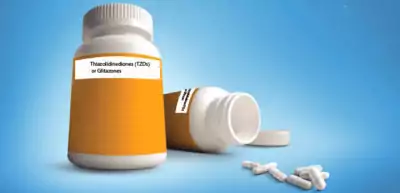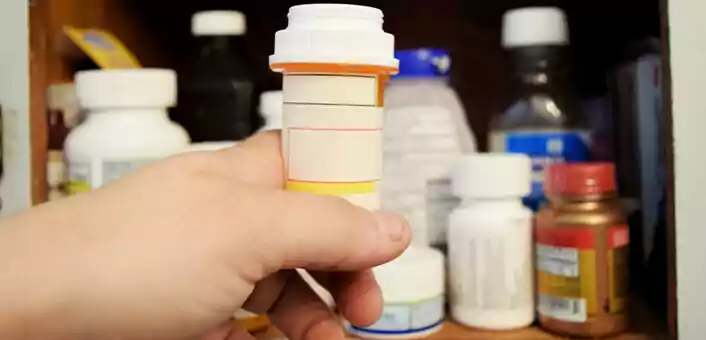
Drug Side Effects
What are TZDs – Thiazolidinediones Side Effects
Nov 25, 2016Introduction
Type 2 diabetes occurs due to muscle, fat and liver cells not being able to use insulin properly. This is a condition called insulin resistance. Thiazolidinediones (TZDs or Glitazones) are a class of drugs that reduce insulin resistance. When cells resist insulin (the hormone produced by the pancreas that helps control blood sugar levels), it means insulin is being produced but isn’t being used effectively in the body. The insulin is unable to deliver sugar to muscle and fat cells, so sugar backs up in the bloodstream instead. Please note, that thiazolidinediones don’t increase insulin production. They increase the effect of the available insulin, reducing insulin resistance at a cellular level.
Thiazolidinediones are used alongside a diet and exercise program and, also, with other medications, for the treatment of T2D.
Thiazolidinedione is not used in the treatment of:
Type 1 diabetes – A condition in which the body is unable to produce insulin and, therefore, cannot control the amount of sugar in the blood.
> Diabetic ketoacidosis – A serious condition that may develop if high blood sugar is not treated.
Most Prescribed Names In This Category of Drugs Include
- Avandia (Rosiglitazone)
- Actos (Pioglitazone)
- Pioz Mf-G
- Triglycomet
- Trigulin
- Piomed
- Glucut-GMP
Rosiglitazone and Pioglitazone are two drugs in this class that have faced a lot of flak due to safety concerns. Both of these drugs work by increasing the body’s sensitivity to insulin.
Often, the side effects of TZDs are anticipated by doctors. But, you need to be aware of them so that you can flag them to your doctor in case they show up.
How Should This Medicine Be Used?
Thiazolidinediones (Pioglitazone and Rosiglitazone) are available in tablet form. Pioglitazone is usually taken once daily, while Rosiglitazone is usually taken once or twice daily. Both may be taken with or without meals. But, it is important to take the medication at the same time every day.
- You should, also, follow the directions mentioned on your prescription leaflet with utmost care.
- Clarify any part of it that you do not understand with your healthcare practitioner or pharmacist.
- Always take the medication as per the directions given by your healthcare practitioner or pharmacist.
- It could prove dangerous to consume more or less of a dose or to take it more often than prescribed by your doctor.
Side Effects That Could Occur As Soon As You Start Taking the Medication
The most common side effects of Thiazolidinediones that you could face are –
- Water retention – Leading to swelling or edema, including a feeling of heaviness in the body and tendency to be inactive.
- Cardiac issues – Including increased blood pressure, because of which there is elevated pressure on the heart as well. This could eventually lead to heart failure.
- Increased cholesterol levels – The medication has been shown to elevate LDL levels in patients.
Let us take a look at each of the above common side effects in detail.
Water Retention
The body’s salt balance is determined by your diet and body type and is usually well regulated. Thiazolidinediones can upset this delicate balance and cause the kidneys to retain salt. Since the body needs to keep the corrosive salt diluted, it begins to retain water. This excess water puts pressure on your circulatory system. It seeps out of the blood vessels and accumulates within your body, leading to edema and swelling.
Heart Failure
The connection between thiazolidinediones and heart failure has been studied in detail. Prolonged use of thiazolidinediones may lead to a considerable amount of fluid retention. This increases the pressure on the heart and can lead to heart failure. The circulatory system of the body is a closed system, with the amount of fluid determining the blood pressure you feel. If there is too much pressure on the heart, failure is a possibility.
Increased Low-density lipoprotein (LDL) cholesterol Levels
You may notice an increase in your LDL levels after initiating thiazolidinedione therapy. Rosiglitazone has a much more pronounced effect in increasing serum LDL levels than pioglitazone.
(LDL cholesterol is considered the “bad” cholesterol because it is responsible for the generation of plaque – a thick, hard deposit that can block arteries and make them rigid.)
TZDs have not been studied for nutrient depletion effects.
What Can You Do About It?
TZDs are normally prescribed only if metformin or other medications, like sulfonylureas, are not tolerated well or fail to lower blood glucose levels sufficiently.
If you have been put on TZDs and want to continue with them, certain dietary supplements that reduce water retention and aid heart health may help to reduce their side effects. These are generally safe but it would be a good idea to keep your medical practitioner involved.
What May Help With Swelling and Heart Health (Per Day)
- Fish Oil (eicosapentaenoic acid – a component of fish oil): Up to 6g
- CoQ10: 100 mg
- Daflon (90% diosmin and 10% hesperidin): 3g
Should You Be Using TZDs For A Long Term?
Long term usage of these drugs can have adverse effects, since they deplete certain vital nutrients from the body. Specific nutrient depletions have not been studied for Thiazolidinediones (Pioglitazone / Rosiglitazone.) But, it is quite likely that their action on the body depletes certain vital nutrients, leading to a host of other health complications.
What Special Precautions Should You Follow?
Before taking thiazolidinediones,
Inform your doctor and pharmacist in case you are allergic to TZDs (Pioglitazone/rosiglitazone) or any of the substances in TZD tablets, including other medicinal drugs.
Let your doctor and pharmacist know if you’re taking, or planning to take, the following in the near future:
- Prescription medications
- Non-prescription medications
- Nutritional supplements
- Vitamins and herbal products
These might affect how TZDs act in your body and your doctor might have to adjust the dosage accordingly.
- Ask your physician what you should do in case you fall ill / get an infection or fever / are injured. These conditions could affect your blood sugar and the amount of TZDs you might need.
- Inform your physician if you are pregnant / plan to get pregnant / are breastfeeding. In case you become pregnant after being started on TZDs, call your doctor.
Important: Do not breastfeed if you’re taking pioglitazone.
What Should You Do If You Forget A Dose?
Take the forgotten dose as soon as you remember it. But, if it’s time for the subsequent dose, let the forgotten dose pass and continue with your regular dosing schedule. Do not take a double dose to make up for a missed one.
What You Should Know About The Storage And Disposal Of This Medication
TZDs should be stored at 25°C (77°F).
Always keep the tablets in a tight, light-resistant container.
Protect the container from moisture and humidity.
Dietary Considerations While Medicating
Make sure you follow all the exercise and dietary recommendations provided by your healthcare practitioner or dietitian. It is vital to practice a healthy weight-reduction plan, if required, and to exercise often. This will help you keep your diabetes under control and will, also, assist TZDs in acting more effectively.
Drug interactions
Pioglitazone
Gemfibrozil: The maximum recommended dose of pioglitazone is 15mg daily, if used in combination with gemfibrozil, since it significantly increases the concentration of pioglitazone in the blood.
Rifampicin: Rifampicin significantly decreases the concentration of pioglitazone in the blood. Therefore, if rifampicin has been started or stopped during a treatment involving pioglitazone, you may need to make some changes in your treatment regimen. The changes will be based on your clinical response to these drugs used together. But, the maximum recommended daily dose of pioglitazone will not exceed 45 mg.
Rosiglitazone
Gemfibrozil has been shown to increase the concentration of rosiglitazone in blood, while rifampicin decreases its concentration (the same reactions as when they are taken along with pioglitazone.) Therefore, if gemfibrozil or rifampicin has been started or stopped during a treatment involving rosiglitazone, the dosage of rosiglitazone should be changed, based on clinical response.
Who Should Not Take TZDs?
You should not take pioglitazone if you have –
- Congestive heart failure / heart disease
- Heart failure with symptoms, such as shortness of breath or swelling. Even if these symptoms are not severe, pioglitazone may not be right for you.
You should not take rosiglitazone if you –
- Have heart failure
- Are allergic to rosiglitazone or any of the ingredients in the rosiglitazone formulation
Severe allergic reactions caused due to ingredients in the rosiglitazone formulation may include:
- Skin problems such as swelling of your face / lips / tongue / throat
- Problems with breathing or swallowing
- Skin rashes or itching
- Red, raised areas on your skin (hives)
- Blisters on your skin / nose / eyes / in your mouth
- Peeling of your skin
- Fainting or feeling dizzy
- Very rapid heartbeat
What Are The Ingredients In TZDs?
Ingredients in ACTOS (Pioglitazone) –
Active Ingredient: Pioglitazone hydrochloride
Inactive Ingredients: Lactose monohydrate, hydroxypropyl cellulose, carboxymethyl cellulose calcium and magnesium stearate.
Ingredients in AVANDIA (Rosiglitazone)
Active Ingredient: Rosiglitazone maleate.
Inactive Ingredients: Hypromellose 2910, lactose monohydrate, magnesium stearate, microcrystalline cellulose, polyethylene glycol 3000, sodium starch glycolate, titanium dioxide, triacetin and 1 or more of the following –
- Synthetic red iron oxides
- Synthetic yellow iron oxides
- Talc
Parting Thoughts
Type 2 diabetes is a dietary disorder. If there is a positive change in one’s diet, along with a change in lifestyle and habits, diabetes can be reversed. Changes that include intermittent fasting, yoga, meditation, weight loss and moderate exercise can have a huge impact on diabetics. Having a positive attitude towards life and accepting your diabetic condition will give you a mental outlook that is stable and free of excessive stress.
References:
1. Nutritional Medicine: Alan R. Gaby, M.D., https://www.ncbi.nlm.nih.gov/pubmed/19236215.






